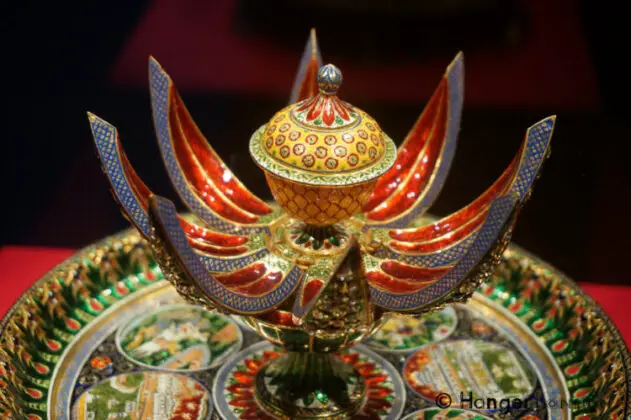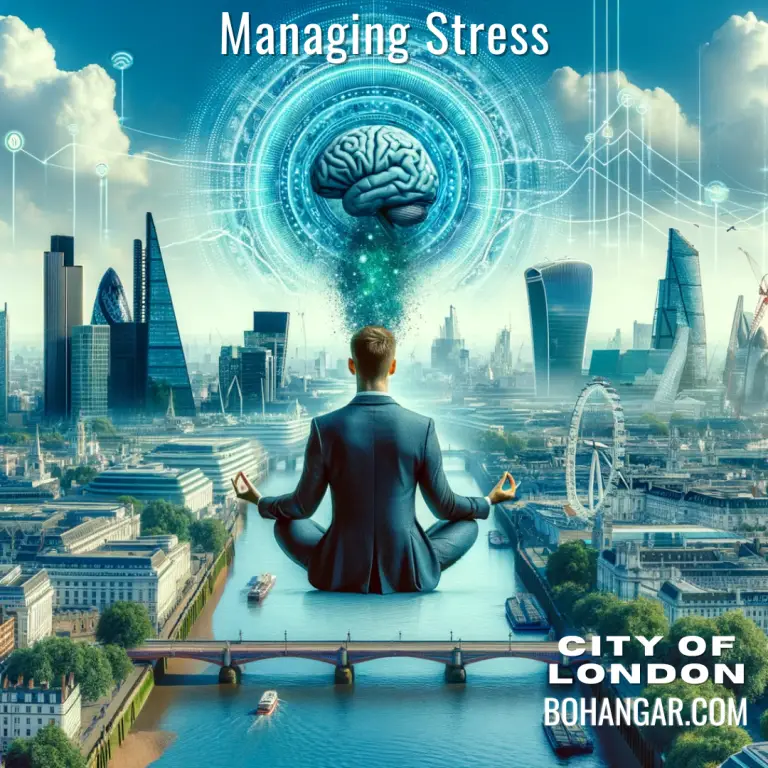In 1875-76, the Prince of Wales embarked on a grand tour of India and Southeast Asia, a journey that was as much about diplomacy as it was about spectacle. The Prince, who would later become King Edward VII, was tasked with strengthening Britain’s political and economic ties with the region, and his trip was marked by grand receptions, cultural exchanges, and impressive displays of British power and prestige.
But the Prince’s journey was not all about politics and diplomacy. Along the way, he was treated to a dazzling array of sights and experiences, from the opulent palaces and temples of India to the lush jungles and idyllic beaches of Southeast Asia. He was feted by maharajahs and sultans, dined on exotic delicacies, and witnessed the intricate dances and performances of local cultures.
The Queens Gallery Exhibition – Splendours of South East Asia
This Queen’s Gallery hosted in 2018, an exhibition of the Prince of Wales’s trip to India, which lasted four months from November 1875. Albert Edward, Prince of Wales, the eldest son of Queen Victoria, who would become King Edward VII.
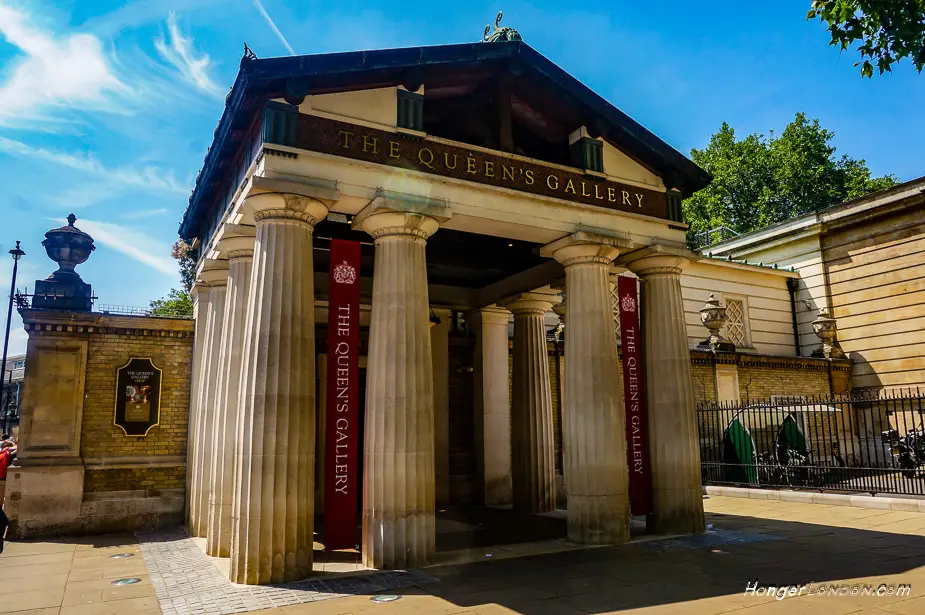
Queens Gallery open to the Public in Buckingham Palace
The Queen’s Gallery is a public art gallery located in Buckingham Palace, London. It is one of the many royal collections that are open to the public and managed by the Royal Collection Trust. The gallery hosts a changing program of exhibitions throughout the year, showcasing a wide range of art and treasures from the royal collection, including paintings, drawings, sculptures, and decorative arts. The gallery’s collection includes works by many famous artists, such as Leonardo da Vinci, Michelangelo, and Rembrandt, as well as many historic and rare objects. The Queen’s Gallery is a popular attraction for visitors to Buckingham Palace and offers a unique insight into the royal family’s history and legacy.
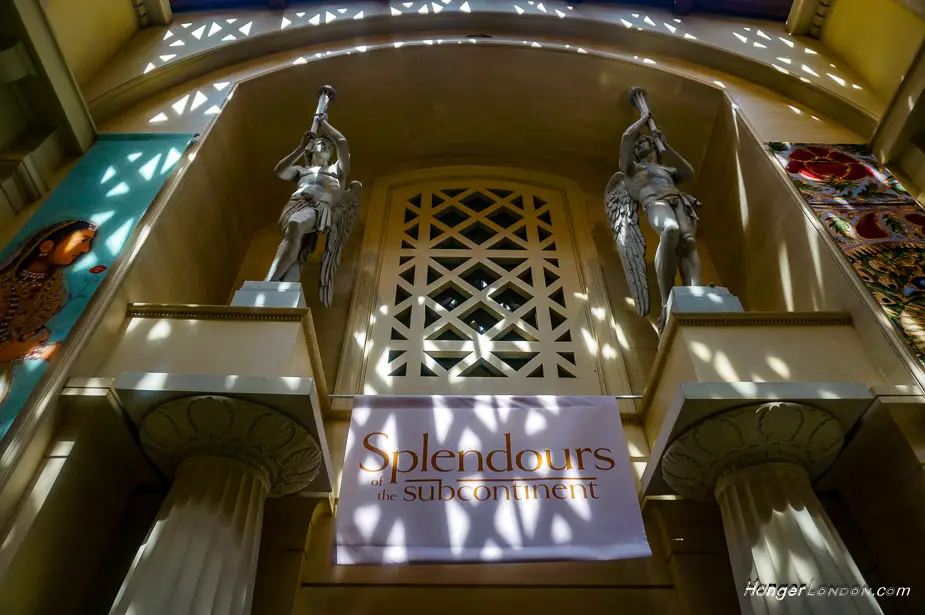
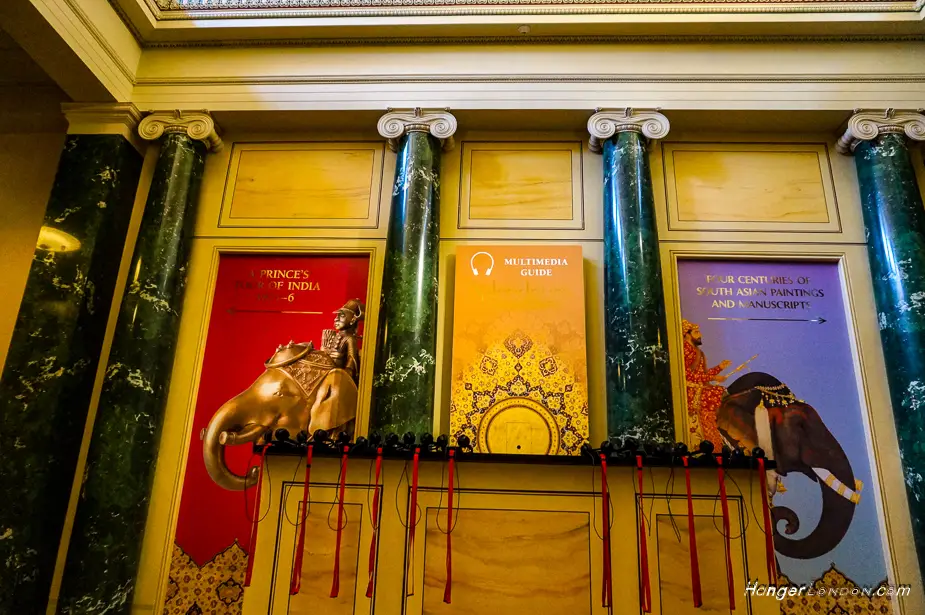
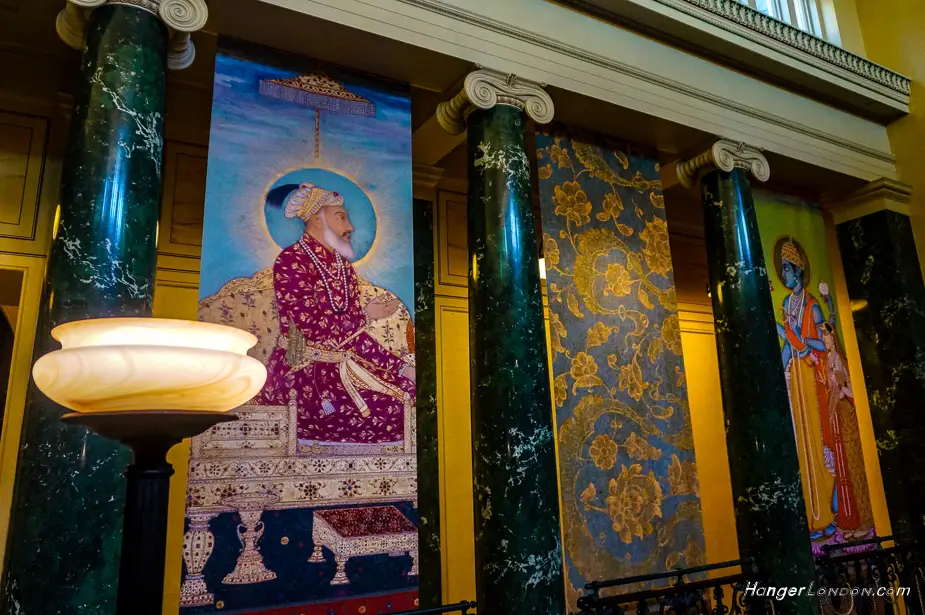
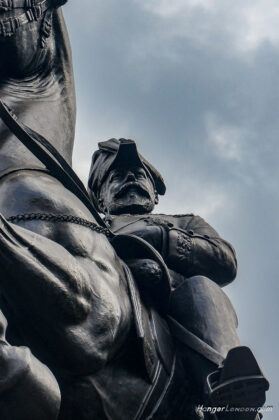
1st Stop Bombay
His first stop was Bombay. The journey was recorded by an Artist Sydney Prior Hall and an established Journalist William Howard Russell who kept a journal of the trip.
This exhibition looks at the Gifts that India gave to the Prince and the British royal family. It also looks at 4 generations of Indian Manuscripts text and artworks that feature Hindu, Sikh, and Muslim presentations.
Shortly after the Prince Returned to England by mid-1876 the gifts were put on display at the Indian Museum in South Kensington London, which then later became the V&A Museum.
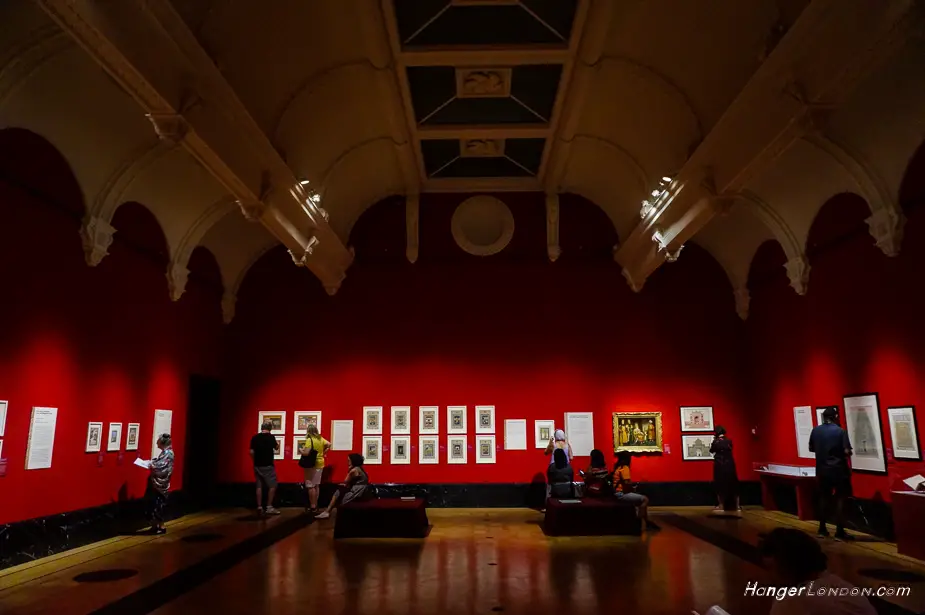
The exhibition traveled to other locations in Scotland and the UK and to Paris and reached Copenhagen in 1882.
30,000 people visited this exhibition in the first week in London in the past. This encouraged the British manufacture and sale of Indian-inspired gift items.
The British Crown Rule of India started in 1858 and was termed the British Raj. The British Raj was made up of Queen Victoria as the monarch of that time, British India Government and the Viceroy, and the India Office in London. Prior to 1858-57, the British Royal Charter had been given to the East India Company to trade, by Elizabeth the 1st in the early 1600s.
In 1958 2/3 of the Subcontinent was ruled by the British Raj. Many cultures, languages, and religions make up India. British Rule ended when the Partition of India happened, in August 1947. Independence was then gained, but at a cost that India was then split into two countries India and Pakistan. The Hindu faith, Sikhism, and the Muslim faith encountered turmoil, fatalities, trauma, loss upheaval separation when partition happened.
This exhibition shows artifacts of India, in a time before all the changes occurred. The Prince needed to keep political and trading relationships with various rulers he met approx. 90 and also exchanged gifts from England.
After a hot day out at the mall, sightseeing, perhaps the changing of the guards or the beauty of the Royal Parks, we found it a cool haven in a pleasant gallery that gave escape to another time, another place.
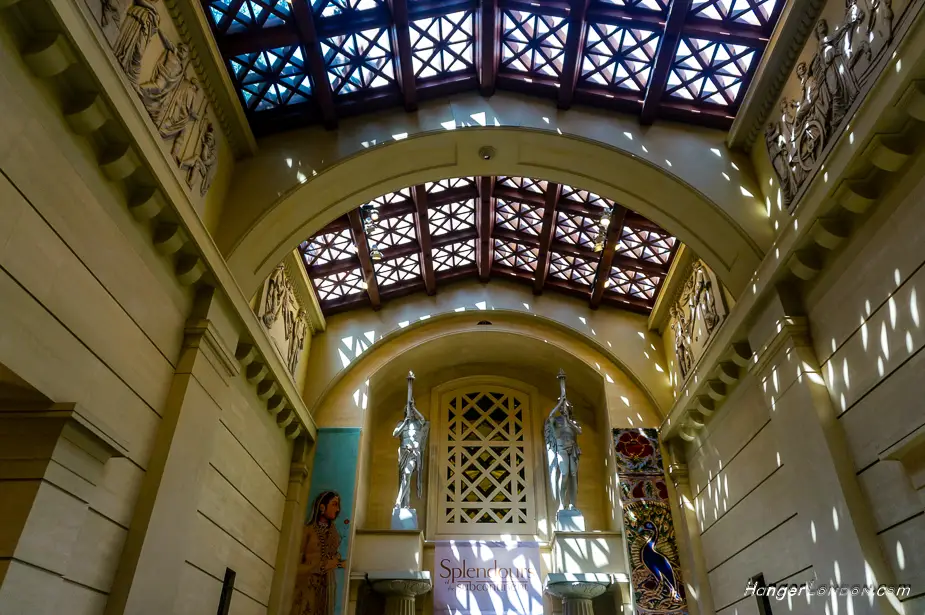
Some of the Places the Prince of Wales visited
Kashmir, Benares, Sail down the River Ganges Baroda, Gwalior, Jaipur, Indore, Northern & Easter Provinces of Ceylon, Punjab, Calcutta, Pudukottai, Mysore. Khairpur,
Processions, embellished pavilions, and illuminated decorations were put up to welcome the Prince.
Highlights of the Gifts.
Inkstand
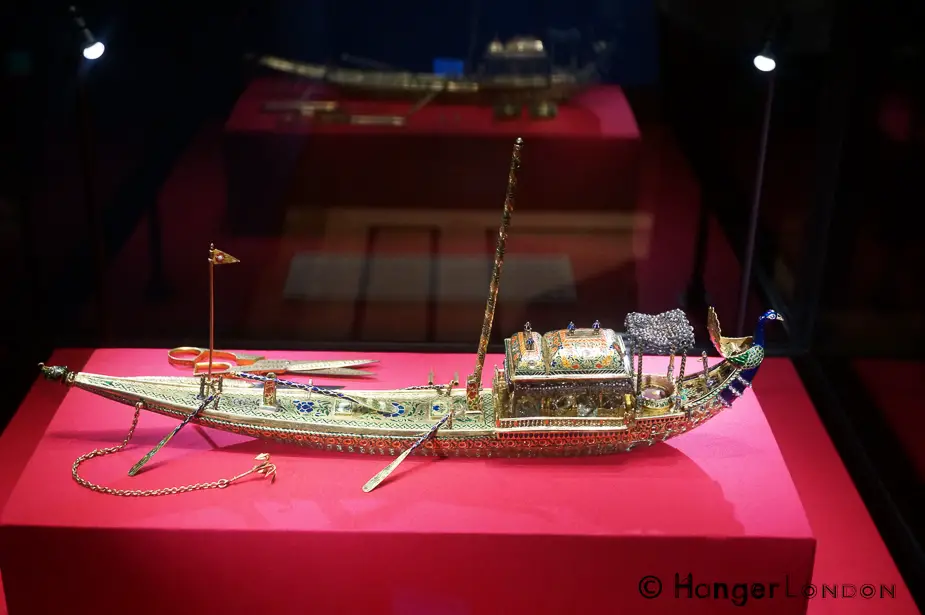
A model of Maharaja’s elaborate Barge that the King sailed on the Ganges with. It was an Inkstand in the shape of a boat coming apart into 19 different pieces. Containing silver-gilt thread, silk, sapphires and diamonds, gold, enamel, pearls, rubies, and glass. Given to the Prince by Ishwari Prasad Narayan Singh Maharaja of Benares.
Address cases & caskets
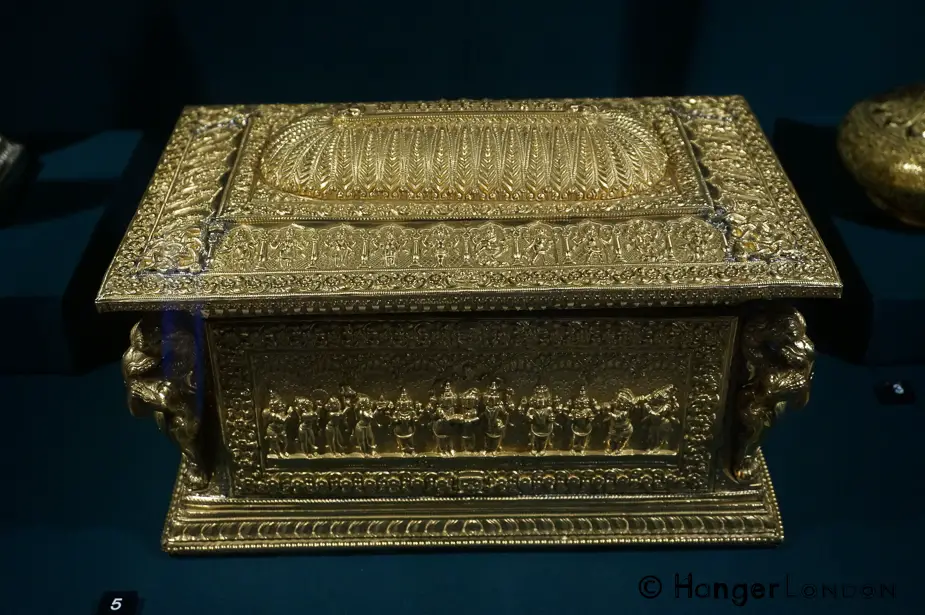
The Prince was presented with cases or caskets, that look a bit like lavish cigar boxes or jewelry boxes when he visited various locations to welcome him and commemorate his stay.
The Prince was presented with a decorated Gold hinged rectangular case That contained the king’s crest on the top. Inside a type of document, but made of silk, embellished & decorated with 96 gold flowers as an address to the king. Gold, diamond, rubies, silk. Showing the Goldsmiths’ skill of the Tamil culture from the Ceylon region.
Another casket was made of ivory and gold embellished with gems such as pearls, amethyst, garnets, sapphires, and chrysoberyls. Ceylon grew spices, which were presented in this box. Pepper, Coffee, vanilla, betel nut which is used as a mouth refresher called Paan, and cinnamon.
Hammer from the Railways
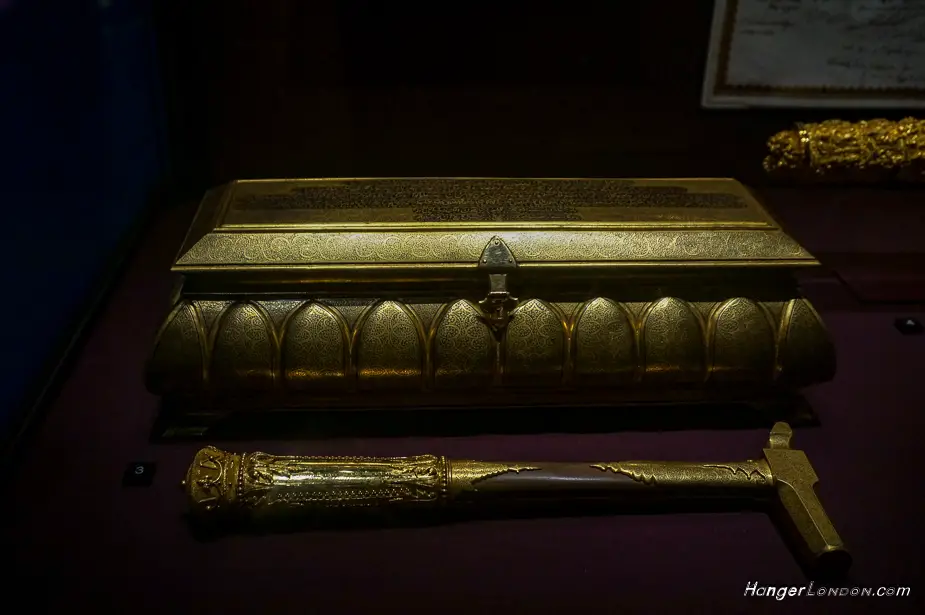
One of the Longest Bridges in the world was nearly at completion in 1876. The Prince was given the honor of hammering in the last rivet into the Alexandra Bridge, over the River Chenab, Wazirabad, during this tour. The Metal hammer was presented to the Prince it had intricate metal craftsmanship, in Kulkarni style, and a case to hold it in. The Acanthus’s distinct foliage leaf and scrollwork were embellished into features. A Gift from the Punjab Northern State Railways.
From the Maharaja of Jaipur, with Gold, pearls, enamel, gold sequins, diamonds, glass. A Ruler is traditionally cooled by attendants using these grand fans.
Indian court service items
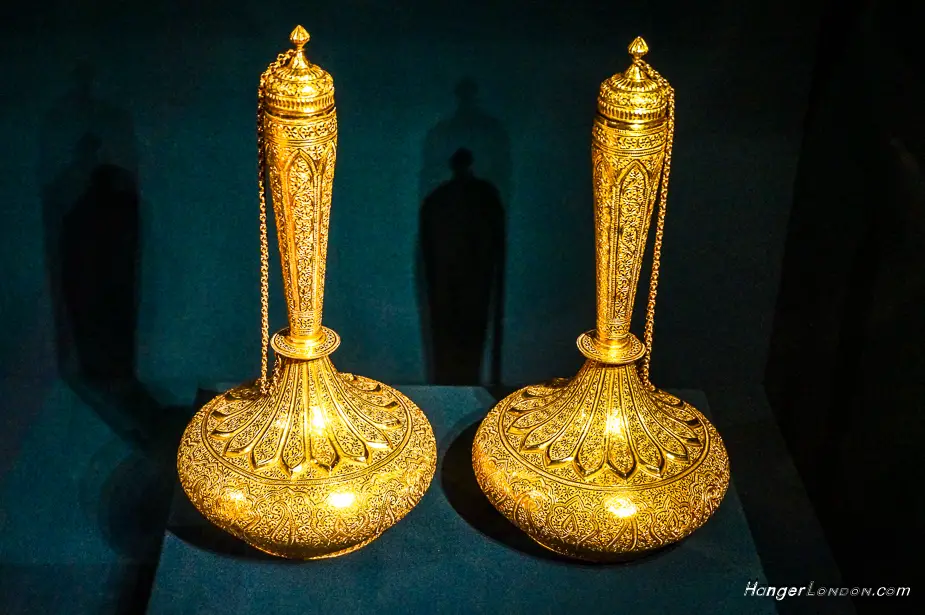
Salvers, rose water sprinklers, Perfume holder, Betel nut holder, gold Embellished metalwork bottles.
Perfume holder is a pot that is held in an opening lotus flower-shaped container on a dish. Embellished with Gold enamel, diamonds, pearls, colors of green, red, yellow. From Jaipur
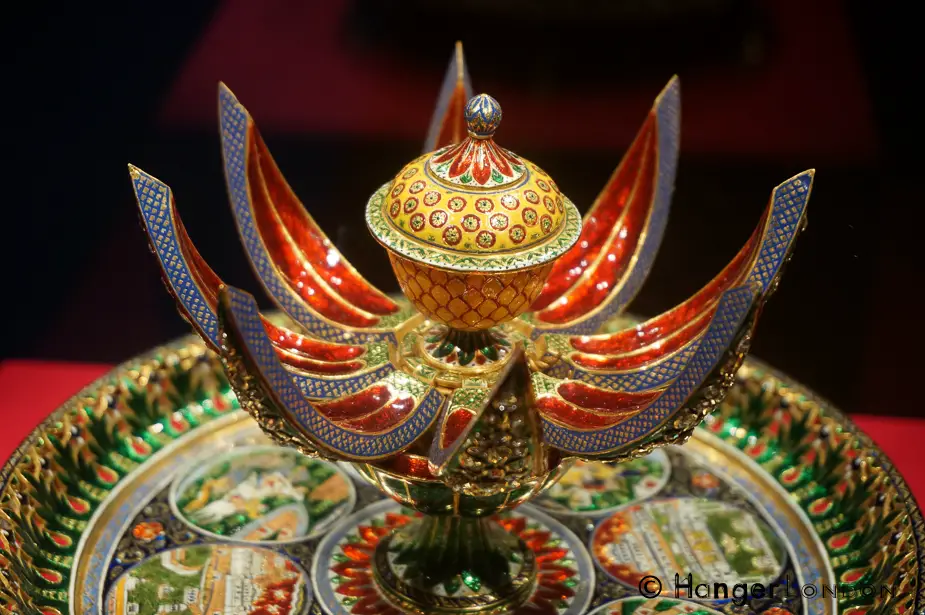
Lotus Perfume holderEnameled Gold red, green yellow pearls, diamonds elephant figurines yali Hindu faith form the stand.
A Gift from Ram Singh II Maharaja of Jaipur. 1876 Normally these would have held rose water
the design incorporates the Chandra Mahal and Amber Fort in Jaipur.
Enameled Gold red, green yellow pearls, diamonds elephant figurines yali Hindu faith form the stand.A Gift from Ram Singh II Maharaja of Jaipur. 1876 Normally these would have held rose water
the design incorporates the Chandra Mahal and Amber Fort in Jaipur.
Weapons: Swords, Scabbards, shields, Dagger, Axe knife
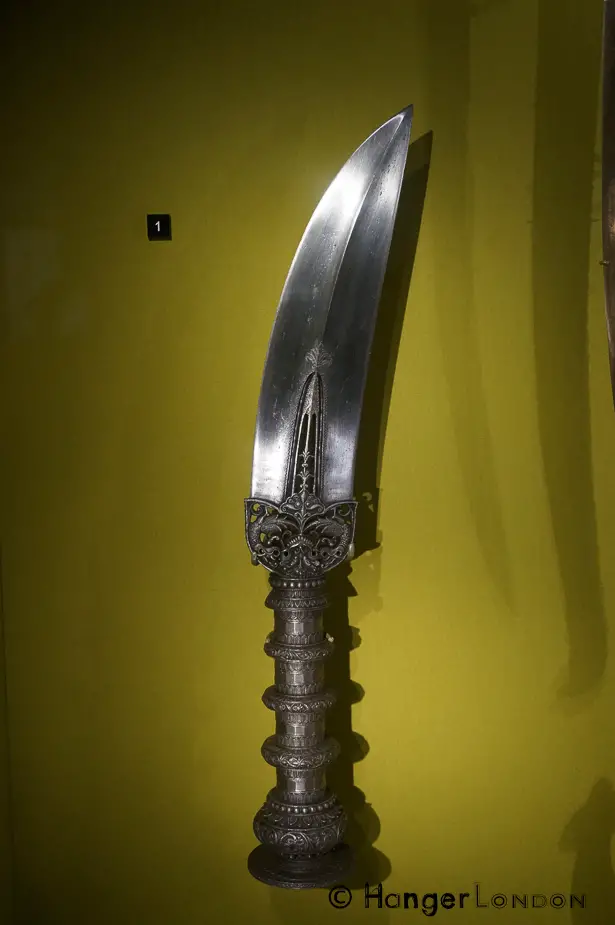
Watered crucible steel
Steel, jade, diamonds, emeralds, rubies, gold, garnets, velvet, silk, pearls, wood enamel, red glass, copper
Indian Kundan technique Jewellery
Gemstones illuminated from behind by foil pressed into place with gold strips
Waist Belt Gift for Princess of Wales Alexandra
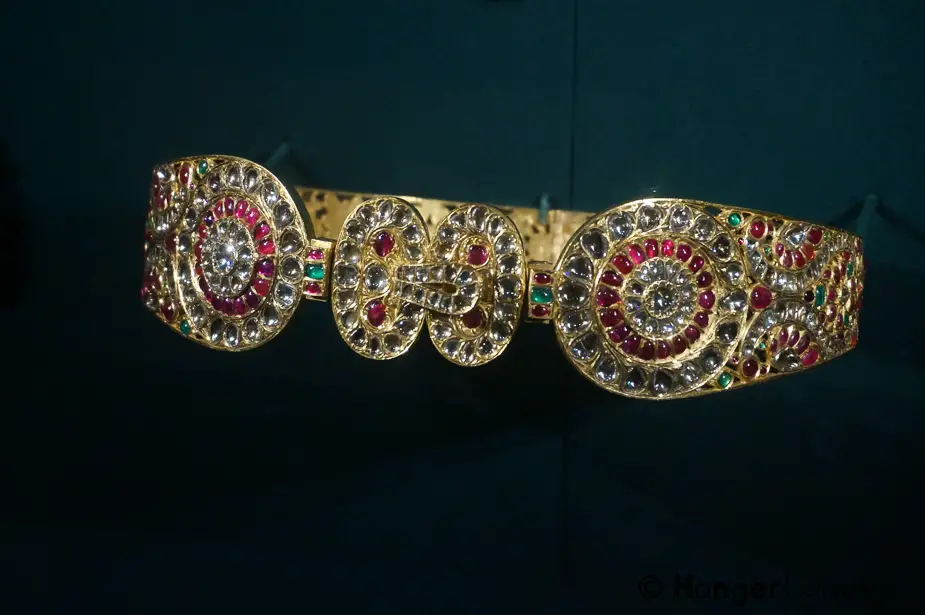
Waist Belt Gift for Queen Alexandra. Whilst their first stop in Bombay. A Gift from Marharaja of Mysore 1875Gold Diamonds, rubies, emeralds
Waist Belt Gift for Queen Alexandra. Whilst their first stop in Bombay. A Gift from Maharaja of Mysore 1875Gold Diamonds, rubies, emeralds
From Bombay made from gold diamonds, emeralds rubies Kundan technique, peacock, and lotus-inspired shapes.
Queen Victoria’s Birthday gift Bangle
From Trichinopoly, noted for its sculptured jewelry, sea animal depiction. Prince selected and bought this bangle as a gift for his Mother, made from Gold and rubies.
Indian enameling
Coloured glass bonded to the metal.
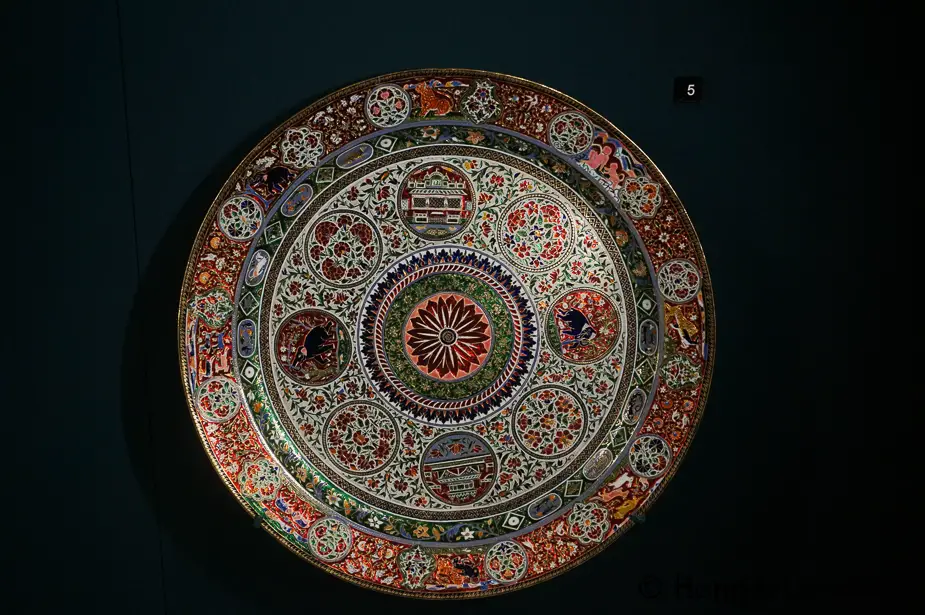
Salver A Gift from Ram Singh II Maharaja of JAipur 1876 Gold, Enamel.This plate and plates like it could take 4 years to make.
4 Centuries of MANUSCRIPTS & PAINTINGS South Asia. 17th C to the 20th C. Some from Indian Rulers to British Monarch.
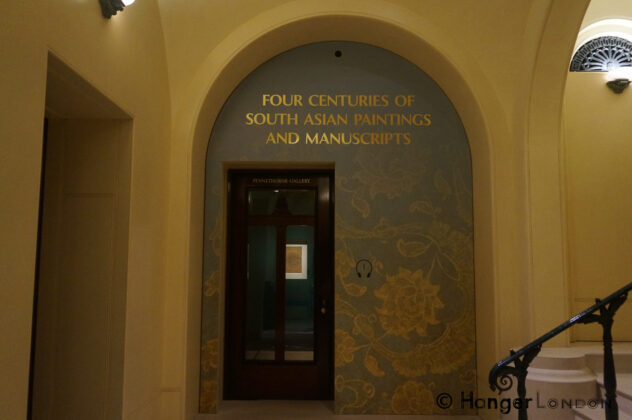
Queen Victoria’s Hindustani diaries and phrase book, where she studied Hindu and Urdu.
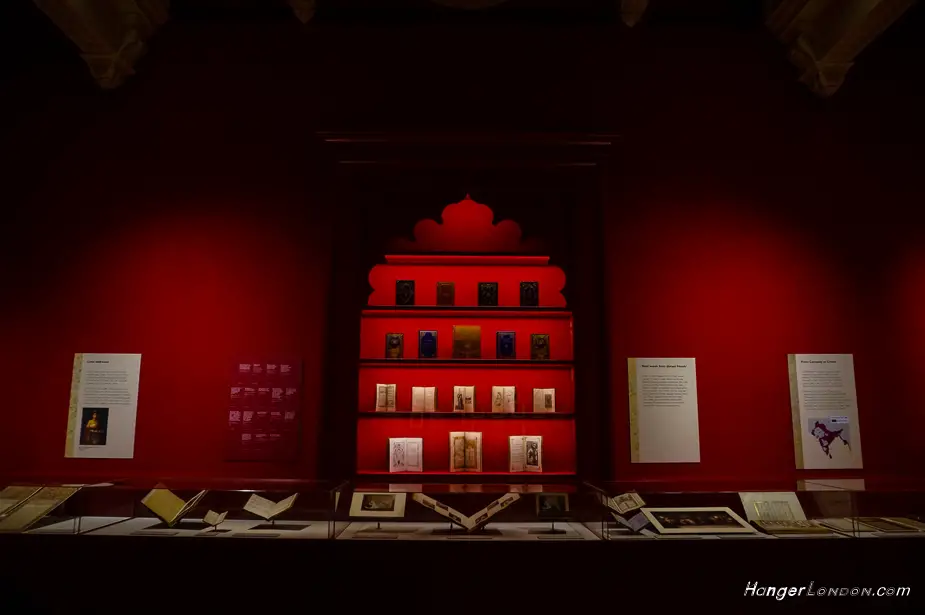
Manuscripts combined authors, artists craftsmen, handwritten books, calligraphy, illuminated illustrations, decorative borders
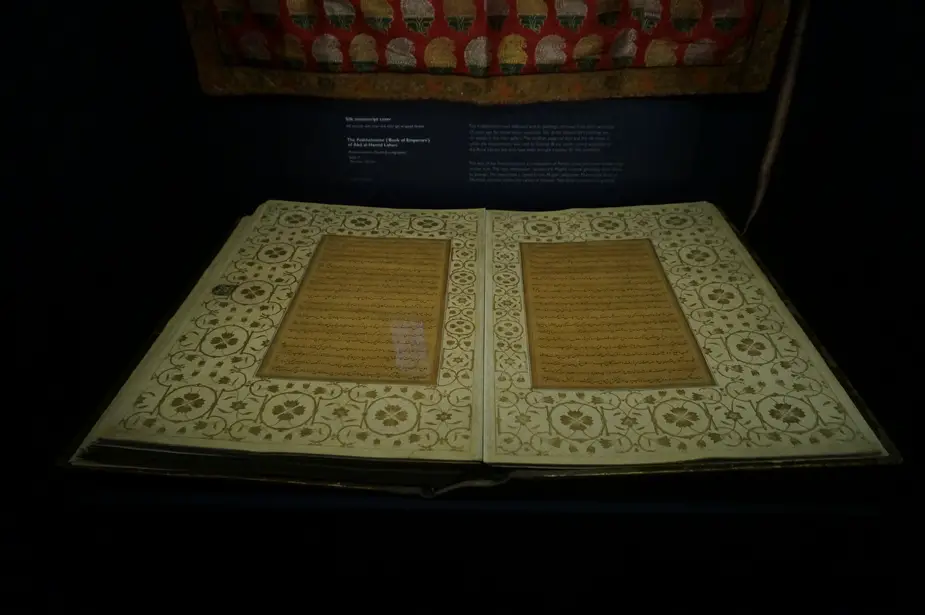
An Opaque watercolor with gold paint and gold leaf from 1492
From the Mughal Dynasty Muslim Persian origin 17th C works that examine their belief that people could be interpreted by studying their portrait.
Mansur wildlife painting from 1600 Opaque watercolor and gold of a reptile chameleon.
Intricate opaque watercolor with gold paint 1657 of the “SUNBURST” Shamsa. A sign of harmony, infinity.
A divine light thought to pass from God to kings without the intervention of men.
Arabic calligraphy, a verse from 1600
The Day of the Judgement 1605-10 Nanha and Manohar has seen in both Christianity and the Muslim faith. Opaque watercolor gold paint
The Gulistan “Rose Garden “ by poet Sa’di written by a fine calligrapher Muhammad Husayn of Kashmiri 1584
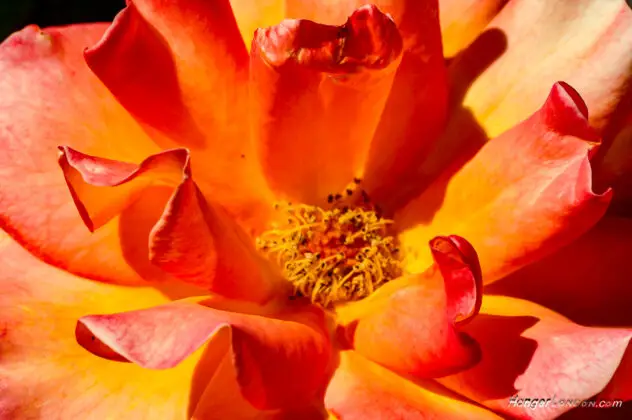
1858 after the partition had ended. Queen Victoria commissioned Egron Lundgren to paint a record of a typical scene. Watercolor beautiful subtle colours Indian women, men in turbans and British officers hosted by Man Singh advisor to Wajid Ali Shah.
Sanskrit poem Gita Govinda by Jayadeva, illustrated pricing
To the Top of the Page
The Absolute story of the Cutty Sark, 1869-2020 victory over tradegy

